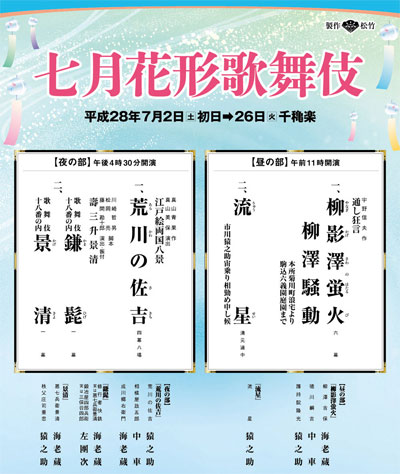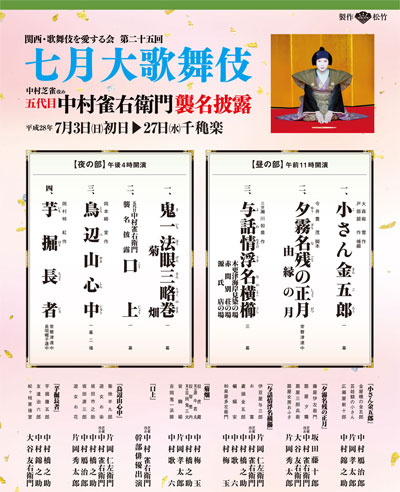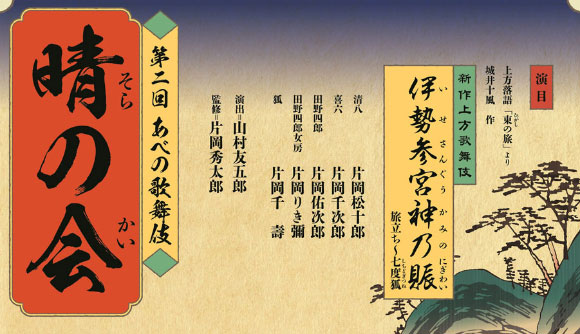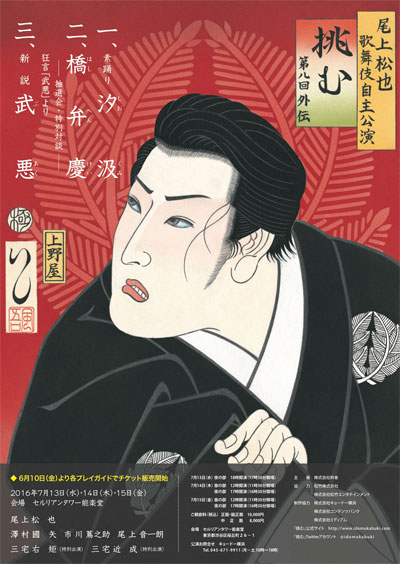| JULY 2016 |
|
4 shows in T˘ky˘ (Kabukiza, National Theatre, Cerulean Tower N˘ Theater), 3 in ďsaka (Sh˘chikuza, Kintetsu Art Kan), 1 in Matsumoto (Matsumoto Performing Arts Centre) and 2 tours (Eastern Provinces, Central Provinces)!
|
| Kabukiza (T˘ky˘) |  |
| Dates | 2 ~ 26 July 2016 (Shichigatsu Hanagata Kabuki) July Young Actors Kabuki |
| MatinÚe |
Yanagikage Sawa no Hotarubi Ryűsei |
| Evening |
Arakawa no Sakichi
|
| Casting |
Ichikawa Ebiz˘, Ichikawa Ennosuke, Ichikawa Sadanji, Ichikawa Chűsha, Nakamura T˘z˘, Ichikawa Ukon, Ichimura Kakitsu, Ichikawa Unosuke, Kataoka Ichiz˘, Ichimura Manjir˘, Ichikawa Omez˘, Ichikawa Monnosuke, Ichikawa Emiya, Ichikawa Emisabur˘, Ichikawa En'ya, Ichikawa Juen, Ichikawa Kudanji, Band˘ Kamesabur˘, Band˘ Minosuke, Sawamura Yoshijir˘, ďtani Keiz˘, Nakamura Yonekichi, Nakamura Takanosuke, Onoe Ukon |
| Comments |
The zagashira for these two July Young Actors Kabuki programs is Ichikawa Ebiz˘ and the main performing troupe will be the Omodakaya under the command of Ichikawa Ennosuke. Ichikawa Sadanji and Nakamura T˘z˘ are also guest stars. A lighter version of "Kotohoide Mimasu Kagekiyo", which was premiered in January 2014 at the Shinbashi Enbuj˘ [more details], is made up of two spectacular dramas, "Kamahige" and "Kagekiyo", which belongs to the Kabuki Jűhachiban collection.
|
 |
| Sh˘chikuza (ďsaka) |  |
| Dates | 3 ~ 27 July 2016 (Kansai Kabuki o Ai Suru Kai Shichigatsu ďkabuki) The 25th Kansai Kabuki Lovers Society July Grand Kabuki |
| MatinÚe |
Kosan Kingor˘ Yűgiri Nagori no Sh˘gatsu Yowa Nasake Ukina no Yokogushi (Kirare Yosa)
|
| Evening | |
| Casting |
Living National Treasure Sakata T˘jűr˘, Living National Treasure Kataoka Nizaemon, Nakamura Jakuemon, Nakamura Ganjir˘, Nakamura Baigyoku, Nakamura Hashinosuke, Kataoka Takatar˘, Nakamura Kinnosuke, Kataoka Hidetar˘, ďtani Tomoemon, Ichikawa Danz˘, Nakamura Karoku, Band˘ Takesabur˘, Kamimura Kichiya, Nakamura Kikaku, Nakamura Kotar˘, Kataoka Matsunosuke, Nakamura Jűjir˘, ďtani Hirotar˘, ďtani Hiromatsu, Nakamura Tanenosuke, Nakamura Muneo |
| Comments |
25th edition of the Kansai Kabuki Lovers Society July Grand Kabuki in ďsaka. Nakamura Jakuemon V celebrates his shűmei in ďsaka at the Sh˘chikuza.
|
 |
| National Theatre (T˘ky˘) |
| Dates | 3 ~ 24 July 2016 (Shichigatsu Kabuki Kansh˘ Ky˘shitsu) July Kabuki Appreciation Class |
| Program |
Kabuki no Mikata |
| Casting |
Nakamura Kaishun, Band˘ Yajűr˘, Band˘ Shűch˘, Nakamura Matsue, Nakamura Kamenoj˘ |
| Comments |
Educational program at the National Theatre called Kabuki Kansh˘ Ky˘shitu ("Kabuki Appreciation Class"). This is a very interesting formula for the beginners because there is lively presentation of Kabuki (or some aspects of the art like music, stage tricks or fighting scenes) on stage, followed by the drama "Yanagi".
|
| Kabuki Tour in the central provinces | |
| Dates | 30 June ~ 24 July 2016 (Sh˘chiku ďkabuki) Sh˘chiku Grand Kabuki |
| Program |
Kabuki no Mikata Fumi Uri |
| Casting |
Nakamura Tokiz˘, Onoe Sh˘roku, Band˘ Kametoshi, Nakamura Baishi, Nakamura Mantar˘ |
| Comments |
The usual July Grand Kabuki Tour in the central provinces!
|
| Kabuki Tour in the Eastern Provinces | |
| Dates | 30 June ~ 31 July 2016 (Sh˘chiku ďkabuki) Sh˘chiku Grand Kabuki |
| Program |
Goaisatsu Sarashi Sanbas˘ |
| Casting |
Ichikawa Somegor˘, Ichikawa Komaz˘, Nakamura Kazutar˘, Nakamura Kash˘, Arashi Kitsusabur˘ |
| Comments |
The usual July Grand Kabuki Tour in the eastern provinces!
|
| Matsumoto Performing Arts Centre (Matsumoto) | |
| Dates | 11 ~ 17 July 2016 (Shinshű Matsumoto ďkabuki) Shinshű Matsumoto Grand Kabuki |
| Program | |
| Casting |
Nakamura Kankur˘, Nakamura Shichinosuke, Nakamura Senjaku, Nakamura Shid˘, Kataoka Kamez˘, Nakamura Tsurumatsu, Sasano Takashi, Manako Keiji, ďmori Hiroshi |
| Comments |
5th edition in the city of Matsumoto (first time in July 2008; second time in July 2010; third time in July 2012; fourth time in July 2014) of a Kabuki program, which is called Shinshű Matsumoto ďkabuki (Shinshű is an old name for the province of Nagano, whose main city is Matsumoto). Same program as the 15th edition of the Cocoon Kabuki in T˘ky˘:
|
|
|||
| Dates | 29 July ~ 1 August 2015 (Sora no Kai) | ||
| Program | |||
| Casting |
Kataoka Matsujűr˘, Kataoka Senjir˘, Kataoka Senju |
||
| Comments |
The 2nd gala of the Sora no Kai (literally 'Sky Society'), in ďsaka at the Kintetsu Art Kan, which stars Kataoka Matsujűr˘, Kataoka Senjir˘ and Kataoka Senju, 3 disciples of the Matsushimaya guild. Sora no Kai literally means "Sky Association". "Ise Sangű Kami no Nigiwai", based on a famous Kamigata rakugo story, is a newly-created drama. It is staged under the supervision of Kataoka Hidetar˘ and the dance master Yamamura Tomogor˘ III. These performances are entitled Abeno Kabuki (Abeno is the name of a famous district in ďsaka). |
||
 |
| Cerulean Tower N˘ Theater (T˘ky˘) |  |
| Dates | 13 ~ 15 July 2016 |
| Program |
Shinsetsu Buaku |
| Casting |
Onoe Matsuya, Miyake Sukenori, Miyake Chikanari, Ichikawa Tsutanosuke, Onoe Otoichir˘, Sawamura Kuniya |
| Comments |
The 8th gala program called Idomu (Challenge) for the young actor Onoe Matsuya. The first item is performed by Onoe Matsuya. The third item is a newly-revised version of the Ky˘gen drama "Bukaku" and it stars Onoe Matsuya and the two ky˘genshi Miyake Sukenori and Miyake Chikanari. |
 |
|
|
| Contact | Main | Top | Updates | Actors | Plays | Playwrights | Programs | Links | FAQ | Glossary | Chronology | Illustrations | Prints | Characters | Derivatives | Theaters | Coming soon | News |
